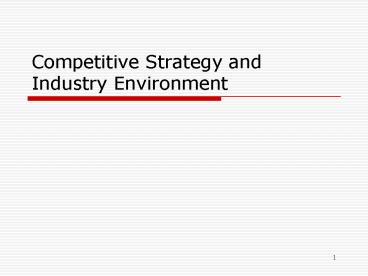Competitive Strategy and Industry Environment PowerPoint PPT Presentation
1 / 23
Title: Competitive Strategy and Industry Environment
1
Competitive Strategy and Industry Environment
2
The Industry Environment
- Positioning a company to sustain competitive
advantage over time in different kinds of
industry environments - Different industry environments present different
opportunities and threats - A companys business model has to change to meet
the environment
3
Strategies in Fragmented Industries
- Fragmented industry characteristics
- Localized markets with low entry barriers (e.g.
Moms Diner). - Few economies of scale opportunities exist.
- High transportation costs for products (e.g.
sand). - Focus strategies predominate (e.g. customer
group, region).
4
Strategies in Fragmented Industries
- Competing in fragmented industries requires
strategic consolidation by - Chaining (Kohls, WalMart, Clear Channel Radio)
- Franchising (McDonalds)
- Horizontal mergers (Dillards)
- Using the Internet (eBay)
- What is a business model?
5
Embryonic and Growth Industries
- Reasons for slow growth in market demand
- Limited performance and poor quality of the first
products - Customer unfamiliarity with what the new product
can do for them - Poorly developed distribution channels
- Lack of complementary products
- High production costs
6
Embryonic and Growth Industries (contd)
- Mass markets typically start to develop when
- Technological progress makes a product easier to
use and increases its value to the average
customer - Key complementary products are developed that do
the same - Companies find ways to reduce production costs
allowing them to lower prices
7
Market Development and Customer Groups
8
Market Share of Different Customer Groups
9
Strategic Implications Crossing the Chasm
- Crossing the chasm between early adopters and the
early majority - Innovators and early adopters are technologically
sophisticated and will tolerate engineering
imperfections (the early majority are not) - Innovators and early adopters are typically
reached through specialized distribution channels
(the early majority are not) - Innovators and early adopters are relatively few
in number and not particularly price sensitive
(the early majority are not)
10
The Chasm AOL and Prodigy
11
Crossing the Chasm
- Correctly identify the needs of the first wave of
early majority users - Alter the business model in response
- Alter the value chain and distribution channels
to reach the early majority - Design the product to meet the needs of the early
majority and so that it can be modified and
produced or provided at low cost - Anticipate the moves of competitors
12
Strategic Implications of Market Growth Rates
- Different markets develop at different rates
- Growth rate measures the rate at which the
industrys product spreads in the marketplace - Growth rates for new kinds of products seem to
have accelerated over time - Use of mass media
- Low-cost mass production
13
Differences in Diffusion Rates
14
Factors Affecting Market Growth Rates
- Relative advantage
- economic or social
- Compatibility
- with prior needs and experiences
- Complexity
- e.g. Mac OS v DOS v Windows
- Trialability
- can it be tested?
- Observability
- can benefits be seen by others?
- Availability of complementary products
15
Strategic Implications of Differences in Growth
Rates
- To increase demand for a new technology or
product - Show its relative advantage, make it compatible
with customers prior needs and experiences,
reduce its complexity, make it possible for
customers to try or observe it, ensure that
necessary complements are in place - Identify and court potential opinion leaders to
promote viral diffusion
16
Strategy in Mature Industries
- Strategies for Deterring the Entry of Rivals
17
Strategies to Manage Rivalry in Mature Industries
- Capacity control strategies
- Preempt rival firms by building capacity ahead of
anticipated increases in demand. - Indirect coordination with rival firms to keep
industry-wide capacity in line with demand. - Mergers and acquisitions
- Pricing Games
- Price Signaling
- Price leadership
- Predatory pricing
- Limit pricing/Dynamic limit pricing
- Nonprice competition
- Product proliferation
- Vertical integration or de-integration
18
Product Proliferation in the Restaurant Industry
19
Limit Pricing Strategy
20
Interesting cases
- Dell v Gateway v HP/Compaq
- How will this industry evolve?
- Toys R Us v WalMart
- Will Toys R Us product proliferation help?
21
Factors that Determine the Intensity of
Competition in Declining Industries
Not all segments in an industry decline at the
same rate!
22
Strategy Selection in a Declining Industry
23
Exercises
- The sales growth in the PC industry is slowing.
- Choose a company in the industry (Dell, HP, IBM,
Apple etc.) and develop a competitive strategy to
deal with this development. - Ebay case
- What is their competitive advantage? How can it
be undermined? Will they drop the ball? What
should ebay do next?

